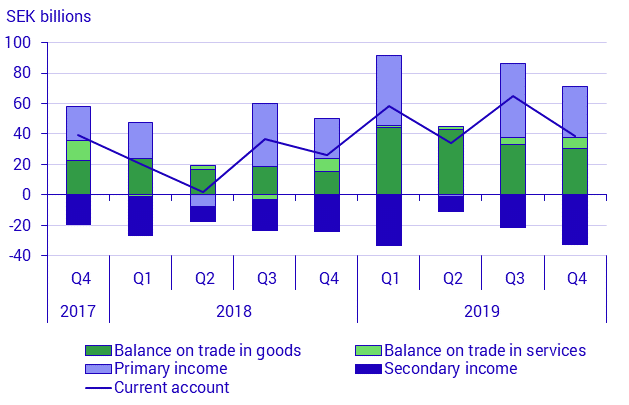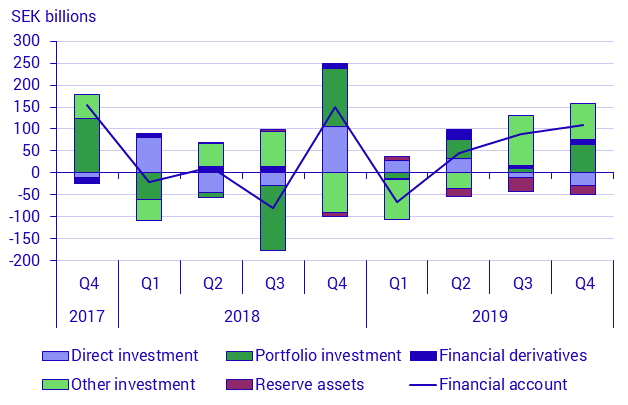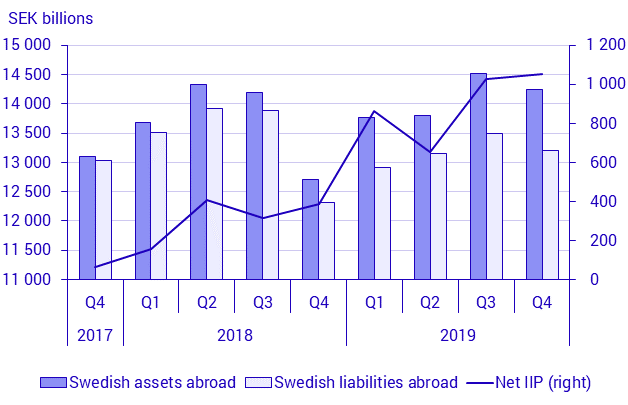Balance of payments, 4th quarter 2019
Increased surplus in balance on trade in goods contributed to positive current account
Statistical news from Statistics Sweden 2020-03-09 9.30
The current account surplus amounted to SEK 38.8 billion in the fourth quarter of 2019, up by SEK 12.6 billion from the fourth quarter of 2018. Balance on trade in goods was the main contributing factor to the higher surplus.
The financial account shows that net lending with the rest of the world amounted to SEK 108.9 billion during the quarter. Sweden’s net external assets position, reported in the international investment position, amounted to SEK 1 050.3 billion at the end of the fourth quarter of 2019.
What is the balance of payments?
The balance of payments is a statement of all Swedish transactions with the rest of the world. It presents exports and imports of goods and services, and includes a description of changes in financial assets and liabilities with the rest of the world. The balance of payments consists of the current account, the financial account, and the capital account. The component parts of the Balance of Payments and related terms are explained under Definitions and explanations, at the end of this item of statistical news.
Current account surplus as share of Sweden’s GDP increased
Sweden’s current account as a share of the GDP has increased in recent quarters, and amounted to 3.9 percent of Sweden’s GDP in the fourth quarter of 2019, calculated as a moving average over the last four quarters. The current account as a share of the GDP last reached this level in the first quarter of 2016.

Comparisons between periods in the current account are made using the corresponding quarter the previous year.
Trade in goods surplus increased
The balance on trade in goods resulted in a surplus of SEK 30.2 billion, up by SEK 14.6 billion from the fourth quarter of 2018. Goods exports amounted to SEK 418.2 billion, up by SEK 5.2 billion compared with the corresponding quarter a year ago. Goods imports amounted to SEK 388.0 billion, down by SEK 9.3 billion in a corresponding comparison. Surplus in merchanting, which is included in the balance on trade in goods, amounted to SEK 24.6 billion, up by SEK 2.8 billion from the fourth quarter of 2018.
Imports and exports of services increased
The balance on trade in services noted a surplus of SEK 7.7 billion, which is a marginal decrease, compared with the surplus of SEK 8.4 billion in the fourth quarter of 2018. Export of services amounted to SEK 188.7 billion, up by SEK 6.4 billion compared with the corresponding quarter a year ago. At the same time, import of services amounted to SEK 181.0 billion, up by SEK 7.0 billion in a corresponding comparison.
Travel, telecommunication, computer and information services were the main types of service to contribute to the increase in exports. Charges for the use of intellectual property, telecommunication, computer and information services were the main types of service to contribute to the increase in imports. At the same time, other business services noted a decline both on the export and import side. Within this type of service, R&D services accounted for the largest decline on the export and on the import side.
Primary income surplus increased
Primary income, which consists mainly of compensation of employees and investment income, presented a surplus of SEK 33.4 billion in the fourth quarter. This surplus rose by SEK 7.0 billion compared with the corresponding quarter a year ago. Investment income was the main contributor to the higher surplus in the primary income; from SEK 25.3 billion to SEK 29.5 billion in a corresponding comparison.
Portfolio investment contributed a surplus of SEK 7.5 billion to investment income, up by SEK 2.2 billion compared with the corresponding quarter a year ago. Investment income on direct investment contributed a surplus of SEK 21.5 billion, up by SEK 1.6 billion compared with the fourth quarter of 2018.
Secondary income deficit increased
Secondary income, which includes grants and donations and contributions to the EU, presented a deficit of SEK 32.4 billion. This deficit increased by SEK 8.2 billion compared with the corresponding quarter a year ago.
Net lending in the financial account
The financial account noted net lending amounting to SEK 108.9 billion in the fourth quarter of 2019. Net lending and net borrowing refer to the overall balance on the financial account.
Portfolio investment, financial derivatives and other investment in the financial account present net lending during the quarter. At the same time, direct investment and reserve assets present net borrowing during the quarter.

Foreign direct investment in Sweden increased
Net borrowing in direct investment amounted to SEK 29.2 billion during the quarter. Foreign direct investment in Sweden increased by SEK 21.4 billion, while Swedish direct investment abroad decreased by SEK 7.8 billion.
Foreign portfolio investment in Sweden decreased
Net lending in portfolio investment amounted to SEK 64.7 billion during the quarter. Swedish investors decreased their portfolio investment abroad by SEK 3.2 billion, while foreign investors decreased their portfolio investment in Sweden by SEK 67.9 billion.
Other investment decreased abroad and in Sweden
Net lending in other investment corresponded to SEK 82.6 billion. Swedish other investment abroad decreased by SEK 153.7 billion, while foreign other investment in Sweden decreased by SEK 236.3 billion.
Financial derivatives and reserve assets
Net lending in financial derivatives amounted to SEK 10.8 billion. Reserve assets noted decreased net lending corresponding to SEK 20.0 billion.
Net assets in Sweden’s international investment position increased
Sweden’s net external assets position amounted to SEK 1 050.3 billion, which is an increase compared with the previous quarter, when net assets amounted to SEK 1 027.4 billion. Portfolio investment contributed most to the increase of net assets, through decreased net liabilities.

Comparisons between periods in the international investment position are made using the previous quarter.
Swedish external liabilities decreased
Swedish external liabilities amounted to SEK 13 201.7 billion, down by SEK 290.9 billion from the last quarter. This change is largely due to a decrease in Sweden’s external liabilities in other investment.
Swedish external assets decreased
Swedish external assets amounted to SEK 14 252.0 billion, down by SEK 268.1 billion from the last quarter. Other investment and financial derivatives were the largest contributors to this decrease.
Sweden’s largest net external assets are in direct investment
Direct investment, reserve assets and other investment account for the largest net external assets. The largest net liabilities are in long-term debt securities in portfolio investment.
Differences between the Balance of Payments and the National Accounts
There are differences between estimations of within Balance of Payments and the National Accounts. Long-term cooperation is under way between the Balance of Payments and the National Accounts to coordinate these statistics.
Revisions
The time series for the Balance of Payments and the international investment position has been revised from Quarter 1 2017.
The Balance of Payments adheres to a predetermined revision policy, see section 2.3 in the 2019 Quality Declaration: Kvalitetsdeklaration 2019. In a compilation of the balance of payments and the international investment position, data based on forecasts are used in some cases. The statistics will be updated as results are received. If new data is added or any methodological changes are made, further revisions are carried out as necessary.
Revisions carried out in connection with publication of the fourth quarter 2019 are listed in the tables on revisions by account item for the balance of payments and the international investment position, respectively.
Definitions and explanations
The current account and the financial account record real and financial transactions with regard to the rest of the world. Only transactions are recorded; value changes, such as exchange rate fluctuations are excluded.
The current account shows the trade in goods (foreign trade in goods), the trade in services (foreign trade in services), primary income (compensation to employees, investment income, other primary income), and secondary income (current transfers). Surplus and deficit in the current account refer to the difference between Sweden’s exports and Sweden’s imports. A positive outcome results in a surplus, while a negative outcome results in a deficit. Comparisons between periods in the current account are always made using the corresponding quarter the previous year, due to seasonal patterns in data.
The financial account consists of direct investment, portfolio investment, financial derivatives, other investment, and reserve assets. Sweden can acquire and dispose of financial assets abroad. All transactions during the quarter concerning external assets show Sweden’s change in net external assets. Sweden can also borrow and repay financial external liabilities. All transactions during the quarter concerning external liabilities show Sweden’s change in net external liabilities. The difference between Sweden’s change in net external assets and Sweden’s change in net external liabilities can be positive or negative, and shows net lending and net borrowing, respectively.
The capital account records Sweden’s capital transfers and transfers of non-financial assets with regard to the rest of the world. Compared with other parts of the balance of payments, amounts in the capital account are usually small.
The difference between Sweden’s financial external assets and liabilities position is the net of Sweden’s international investment position, which can be positive or negative.
An increase or decrease in assets describes Sweden’s external assets. An increase or decrease in liabilities describes Sweden’s external liabilities.
Merchanting, which forms a part of the trade in goods, refers to triangular trade in which goods are purchased and sold abroad without the good crossing a Swedish border.
Next publishing will be
2020-06-08
Statistical Database
More information is available in the Statistical Database
Feel free to use the facts from this statistical news but remember to state Source: Statistics Sweden.
